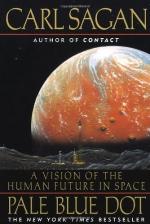
|
| Name: _________________________ | Period: ___________________ |
This test consists of 5 short answer questions, 10 short essay questions, and 1 (of 3) essay topics.
Short Answer Questions
1. How does Sagan describe his reaction to the difficulties in detecting human life and intelligence on Earth from space?
2. What scientist is well-known for writing about the differences between species of animals?
3. The "great demotions" are changes in thinking about the status of what?
4. How old does Sagan state that "fundamentalist monotheists" believe the Earth to be?
5. William Herschel, the discoverer of Uranus, had what unusual profession?
Short Essay Questions
1. How was Sagan involved in discoveries about Titan?
2. What aspects of science make it unappealing to some?
3. What is the problem of perspective in estimating the importance of human beings?
4. What "malevolent" theology does Sagan describe in Chapter 3, "The Great Demotions"?
5. What planets had been explored by human beings, at the time of the writing of this book?
6. As of 1990, what had the Voyager spacecraft achieved?
7. What dangers did the Voyager I spacecraft face in taking a distant picture of Earth?
8. What may have happened to other planets from the early solar system?
9. When this book was written, what was known about planets in other solar systems?
10. Why does Sagan believe that the image of the "pale blue dot" undermined the "imagined self-importance" of humanity?
Essay Topics
Write an essay for ONE of the following topics:
Essay Topic 1
Sagan regards the Voyager craft as triumphs of engineering and human ingenuity. These craft were designed to explore most of the planets in the solar system, and then to journey outwards from it to the stars.
1) Describe the Voyager craft, their missions, and capabilities. What planets were these craft intended to explore?
2) Discuss the differences between the Voyager mission and previous efforts in space exploration. How were these craft significantly different?
3) Explain Sagan's particular interest in the Voyager craft and why he believes them each to be a triumph.
4) Summarize some of the important observations that the Voyager craft made.
Essay Topic 2
Venus was once considered to be a "sister planet" to Earth, but is now known to be dramatically different from our own planet.
1) Discuss the characteristics of Venus, including the oddities in its climate, atmosphere, and surface.
2) Explain some of the similarities and differences between Earth and Venus and explain why this planet was once considered a "sister planet" to Earth.
3) Discuss Venus' unique place in the mythologies of ancient cultures around the world, as well as its unique positioning in the night sky as seen from Earth.
Essay Topic 3
Sagan suggests that the colonization of distant worlds is both feasible and critical to humanity.
1) Explain how does Sagan envisions colonization of distant worlds occurring. What would be the motive for such efforts?
2) Discuss some of the targets that Sagan suggests for colonization, including non-planets.
3) Describe why Sagan believes that colonization is critical to securing the safety of the human race.
|
This section contains 809 words (approx. 3 pages at 300 words per page) |

|




